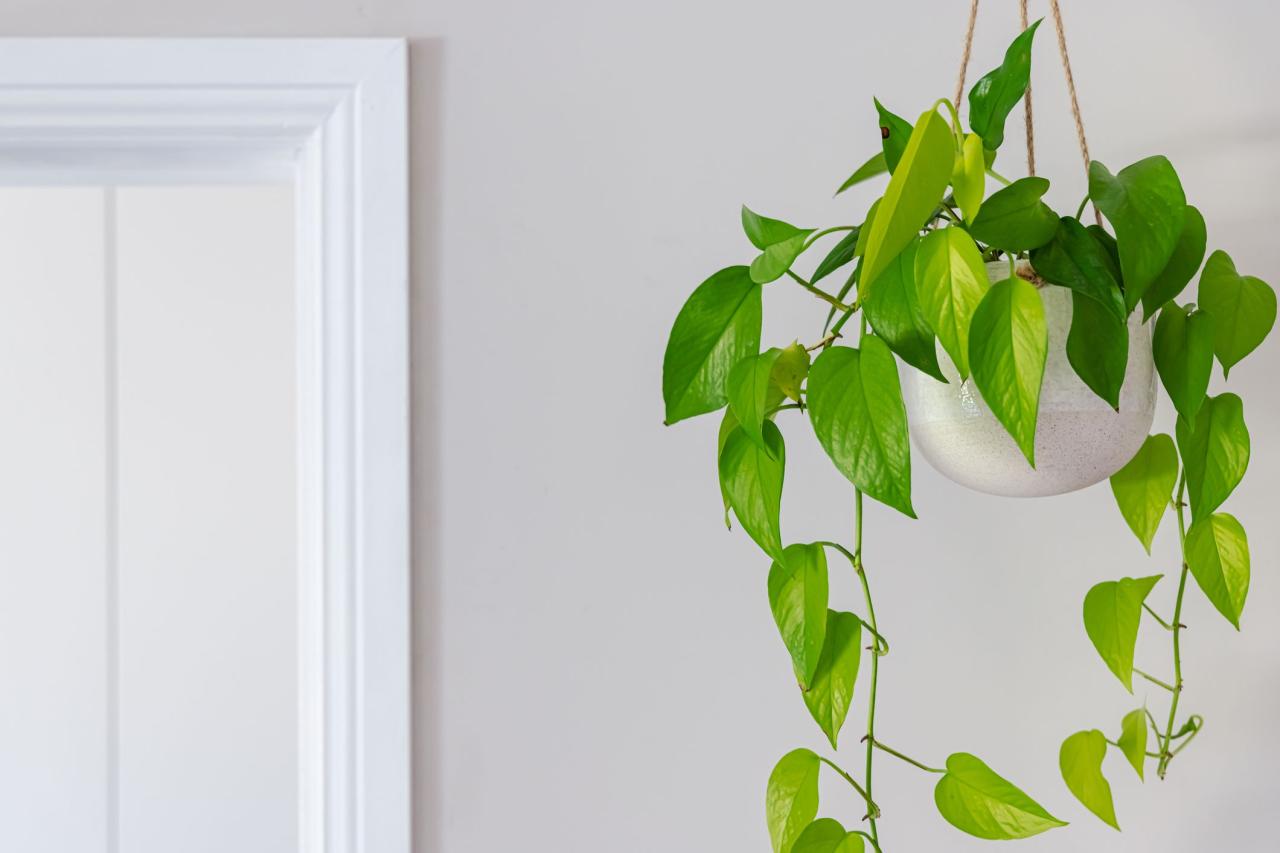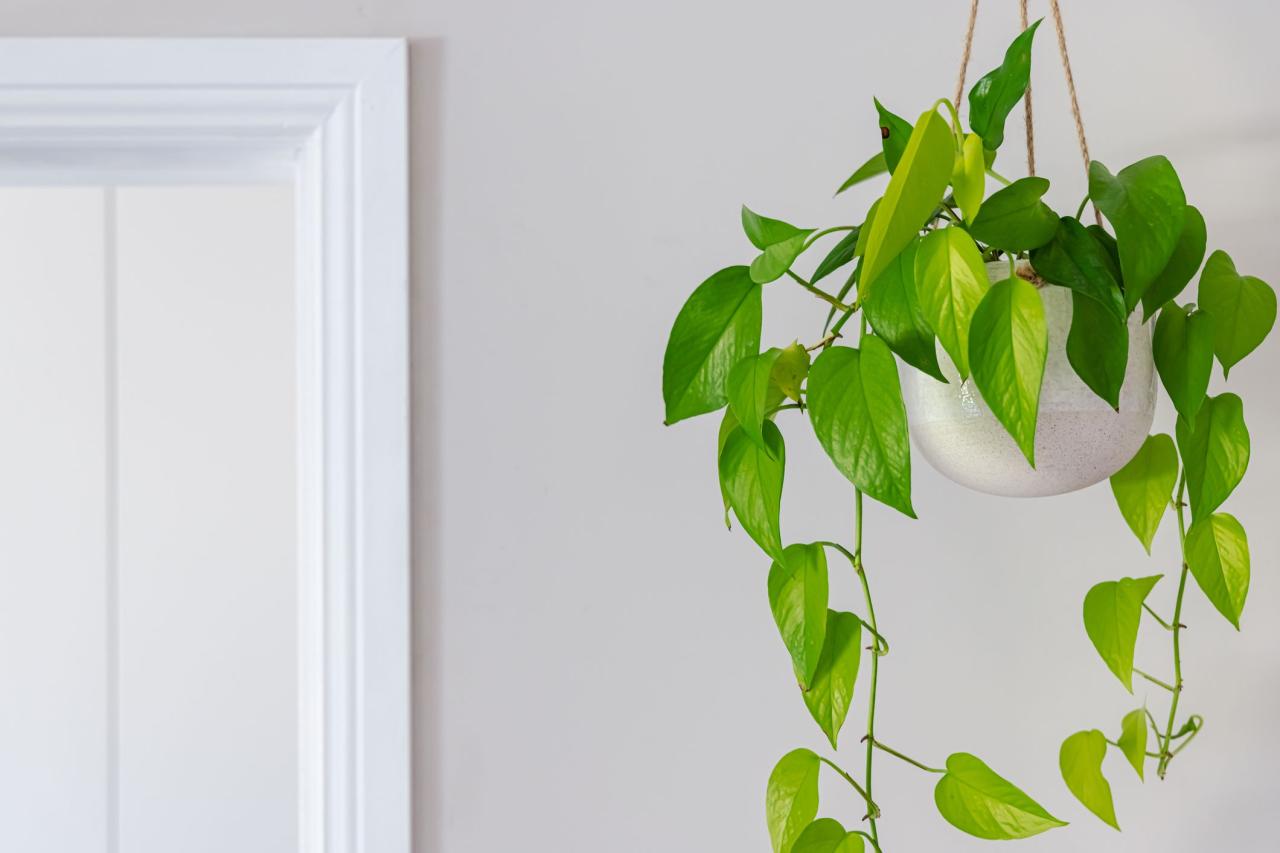The Benefits of Growing Hanging Plants Indoors offer a unique blend of aesthetics, practicality, and well-being. These verdant additions not only enhance the visual appeal of indoor spaces but also contribute to improved air quality and a sense of tranquility.
Whether you’re seeking to liven up a small apartment, create a calming oasis in your home office, or simply add a touch of nature to your surroundings, hanging plants provide a versatile and rewarding solution.
From cascading vines to lush foliage, hanging plants come in a diverse array of species, each with its own unique charm and care requirements. Their vertical growth pattern allows them to maximize space utilization, making them ideal for even the most compact interiors.
Furthermore, the act of caring for these plants can be a therapeutic and rewarding experience, fostering a connection with nature and promoting mindfulness.
Aesthetic Appeal and Space Optimization: The Benefits Of Growing Hanging Plants Indoors
Hanging plants offer a unique way to enhance the visual appeal and functionality of indoor spaces. They add a touch of nature and life to any room, transforming it into a more welcoming and inviting environment. Furthermore, their vertical growth pattern makes them ideal for space optimization, particularly in smaller apartments or rooms.
Benefits of Hanging Plants for Space Optimization
Hanging plants are a fantastic solution for maximizing space utilization in limited areas. They allow you to cultivate greenery without sacrificing valuable floor space. This is especially beneficial in smaller apartments or rooms where every inch counts. By hanging plants from the ceiling or walls, you can create a lush and vibrant atmosphere without cluttering the floor.
Air Purification and Health Benefits
Beyond their aesthetic appeal, hanging plants offer a significant advantage: they can improve indoor air quality and promote a healthier environment. Several studies have confirmed the air-purifying capabilities of various houseplants, including hanging varieties.
The Science of Air Purification
Numerous studies have demonstrated the ability of plants to remove pollutants from the air. A landmark study by NASA in the 1980s investigated the effectiveness of plants in removing volatile organic compounds (VOCs) from enclosed spaces. VOCs are harmful chemicals emitted from common household items like paints, furniture, and cleaning products.
The study found that certain plants, including spider plants and peace lilies, effectively removed VOCs like formaldehyde, benzene, and trichloroethylene.
Hanging plants offer a multitude of benefits for indoor spaces, from purifying the air to adding a touch of natural beauty. Their vertical growth habit makes them particularly well-suited for smaller homes, as they utilize space efficiently without taking up valuable floor area.
If you’re looking for a way to bring the outdoors in without sacrificing precious square footage, consider the advantages of hanging plants, as explained in detail in this article on Why Hanging Plants Are Perfect for Apartments. You’ll find that hanging plants can not only enhance the aesthetics of your indoor environment but also contribute to a healthier and more vibrant living space.
Hanging Plants for Improved Indoor Air Quality
Several hanging plants are known for their air-purifying properties:
- Spider Plant:A popular choice for hanging baskets, spider plants are highly effective at removing formaldehyde, a common VOC found in carpets, furniture, and plywood. A study by the University of Georgia found that spider plants removed up to 95% of formaldehyde from a sealed chamber.
- English Ivy:English ivy is known for its ability to remove airborne pollutants, including formaldehyde, benzene, and toluene. A study by the University of Washington found that English ivy significantly reduced airborne pollutants in a simulated office environment.
- Devil’s Ivy (Pothos):This versatile hanging plant is an efficient air purifier, effectively removing formaldehyde, benzene, and carbon monoxide. A study by the Agricultural Research Service found that pothos plants effectively removed formaldehyde from a closed chamber.
Health Benefits of Hanging Plants
Beyond air purification, hanging plants offer numerous health benefits:
- Stress Reduction:Studies have shown that spending time in nature or even viewing images of nature can reduce stress and anxiety. The presence of plants in the home can create a sense of calm and tranquility, contributing to stress reduction.
- Improved Mood:The visual appeal and the positive psychological effects of plants can contribute to a more positive mood. A study published in the Journal of Environmental Psychology found that the presence of plants in the workplace improved employee mood and satisfaction.
- Enhanced Concentration:The presence of plants can create a more stimulating and focused environment. A study published in the journal “Environment and Behavior” found that students who studied in a room with plants performed better on cognitive tasks than those who studied in a room without plants.
Easy Maintenance and Adaptability
Hanging plants are a popular choice for indoor gardeners due to their low-maintenance nature and adaptability to various environments. Compared to traditional potted plants, hanging plants often require less frequent watering and fertilization, making them an excellent option for busy individuals or those with limited gardening experience.
Adaptability to Different Environments
Hanging plants can thrive in a variety of light conditions, from bright, indirect sunlight to low-light environments. This versatility allows you to find the perfect spot for your plants, regardless of your home’s layout or natural light exposure.
- Bright, Indirect Sunlight:Plants like spider plants, pothos, and philodendrons prefer bright, indirect sunlight. These plants should be placed near a window that receives ample sunlight but avoids direct exposure, which can scorch the leaves.
- Low-Light Conditions:For spaces with limited natural light, consider plants such as snake plants, ZZ plants, and cast iron plants. These plants are highly tolerant of low light levels and can thrive in corners or rooms with minimal sunlight.
Additionally, hanging plants are generally more adaptable to varying humidity levels. Some plants, such as ferns and peace lilies, prefer high humidity, while others, like succulents and cacti, thrive in drier environments.
- High Humidity:To create a more humid environment for plants that prefer it, consider grouping plants together, placing them near a humidifier, or using a pebble tray filled with water.
- Low Humidity:Succulents and cacti require minimal watering and can tolerate dry conditions. Ensure their soil is well-draining to prevent overwatering, which can lead to root rot.
Variety and Diversity

The beauty of hanging plants lies not just in their aesthetic appeal but also in the wide array of options available, each offering a unique character and contributing to the overall ambiance of your indoor space. From delicate ferns to bold succulents, there’s a hanging plant for every taste and preference.
Categorizing Hanging Plants
Understanding the characteristics of different hanging plants helps in choosing the perfect ones for your home. Here are some categories based on their leaf shape, color, texture, and growth habits:
Leaf Shape and Texture
- Trailing:These plants have long, cascading stems that gracefully drape down, creating a flowing effect. Examples include the String of Pearls (Senecio rowleyanus), Spider Plant (Chlorophytum comosum), and the Pothos (Epipremnum aureum).
- Fern-like:These plants exhibit delicate, feathery foliage, adding a touch of elegance and natural beauty. Popular examples include the Boston Fern (Nephrolepis exaltata), Maidenhair Fern (Adiantum raddianum), and the Rabbit Foot Fern (Davallia fejeensis).
- Succulent:These plants have thick, fleshy leaves that store water, making them ideal for low-maintenance indoor environments. Examples include the String of Hearts (Ceropegia woodii), Burro’s Tail (Sedum morganianum), and the Echeveria (Echeveria spp.).
Leaf Color and Pattern
- Green:Classic and versatile, green foliage provides a refreshing and natural feel. Examples include the English Ivy (Hedera helix), the Peace Lily (Spathiphyllum wallisii), and the Snake Plant (Sansevieria trifasciata).
- Variegated:These plants feature leaves with contrasting colors, often with streaks, patches, or edges of white, yellow, or cream. Examples include the Golden Pothos (Epipremnum aureum ‘Golden Pothos’), the Marble Queen Pothos (Epipremnum aureum ‘Marble Queen’), and the Spider Plant ‘Variegata’ (Chlorophytum comosum ‘Variegata’).
The benefits of growing hanging plants indoors extend beyond their aesthetic appeal. They can help purify the air, create a sense of tranquility, and add a touch of greenery to any space. If you’re looking for inspiration on the best types of plants to hang, be sure to check out this comprehensive guide on Hanging Plants.
With a little care and attention, these vibrant additions can thrive indoors, bringing life and beauty to your home.
- Purple:Purple foliage adds a dramatic touch to indoor spaces. Examples include the Purple Heart (Tradescantia pallida ‘Purpurea’), the Purple Waffle Plant (Hemigraphis alternata), and the Wandering Jew (Tradescantia zebrina).
Growth Habits
- Fast-growing:These plants quickly fill their containers and create a lush display. Examples include the Pothos (Epipremnum aureum), the Spider Plant (Chlorophytum comosum), and the Philodendron (Philodendron spp.).
- Slow-growing:These plants grow at a more leisurely pace, making them suitable for smaller spaces or those who prefer a more understated look. Examples include the String of Pearls (Senecio rowleyanus), the Burro’s Tail (Sedum morganianum), and the Air Plant (Tillandsia spp.).
A Selection of Hanging Plants, The Benefits of Growing Hanging Plants Indoors
Common Name |
Scientific Name |
Description |
|---|---|---|
String of Pearls |
Senecio rowleyanus |
Trailing succulent with small, round leaves resembling pearls. |
Spider Plant |
Chlorophytum comosum |
Fast-growing plant with long, arching stems and small, spiderette plantlets. |
Pothos |
Epipremnum aureum |
Versatile plant with heart-shaped leaves available in various colors. |
Boston Fern |
Nephrolepis exaltata |
Delicate fern with feathery fronds, requiring high humidity. |
Maidenhair Fern |
Adiantum raddianum |
Elegant fern with delicate, fan-shaped fronds. |
String of Hearts |
Ceropegia woodii |
Trailing succulent with heart-shaped leaves. |
Burro’s Tail |
Sedum morganianum |
Succulent with long, trailing stems and fleshy, gray-green leaves. |
English Ivy |
Hedera helix |
Trailing plant with glossy, dark green leaves. |
Peace Lily |
Spathiphyllum wallisii |
Elegant plant with white, spathe-like flowers. |
Snake Plant |
Sansevieria trifasciata |
Upright plant with stiff, sword-like leaves. |
Summary
In conclusion, growing hanging plants indoors offers a myriad of benefits, from enhancing aesthetics and purifying the air to promoting relaxation and well-being. With their easy maintenance and adaptability, these versatile plants can transform any indoor space into a vibrant and inviting sanctuary.
Whether you’re a seasoned gardener or a novice enthusiast, incorporating hanging plants into your home decor is a simple yet impactful way to create a more beautiful, healthy, and enriching living environment.
FAQ Summary
What are some popular types of hanging plants?
Popular choices include pothos, spider plants, philodendrons, English ivy, and string of pearls. Each offers unique foliage and growth habits, making it easy to find one that complements your style.
How often do I need to water hanging plants?
Watering frequency depends on the plant species, pot size, and environmental conditions. Generally, check the soil moisture before watering, allowing it to dry slightly between waterings.
Are hanging plants suitable for beginners?
Many hanging plants are relatively low-maintenance and ideal for beginners. Pothos and spider plants are known for their resilience and adaptability.
Can I hang plants in rooms with low light?
Yes, there are many hanging plants that thrive in low-light conditions. Pothos, snake plants, and ZZ plants are excellent options for dimly lit spaces.
